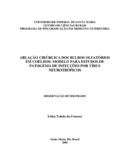| dc.creator | Fonseca, Erika Toledo da | |
| dc.date.accessioned | 2017-06-02 | |
| dc.date.available | 2017-06-02 | |
| dc.date.issued | 2006-12-21 | |
| dc.identifier.citation | FONSECA, Erika Toledo da. Surgical ablation of the olfactory bulb in rabbits: a model to study the pathogenisis of neurotropic virus infections. 2006. 31 f. Dissertação (Mestrado em Medicina Veterinária) - Universidade Federal de Santa Maria, Santa Maria, 2006. | por |
| dc.identifier.uri | http://repositorio.ufsm.br/handle/1/10122 | |
| dc.description.abstract | Rabbits have been used as animal models to study the pathogenesis of neurological infection by bovine herpesvirus type 5 (BHV-5), an important agent of meningoencephalitis in cattle. The olfactory system has been implicated as the main pathway for the virus to reach the brain after replication in the nasal mucosa. To investigate the role of the olfactory route in the pathogenesis of neurological infection, a technique of transfrontal craniotomy for ablation of the main olfactory bulbs (MOBs), using the eyes as the anatomic reference was developed and evaluated. Using this technique, twenty three 30 days-old rabbits were submitted to surgical
ablation of the MOBs and subsequently inoculated with BHV-5. After skin, subcutaneous tissue and periosteum incisions, the craniotomy was performed in a point equidistant to the medial corner of the eyes, with a 3 mm drill coupled to a low intensity elyptic drilling machine. The removal of the MOB s tissue was performed by using a number 6 uretral probe coupled to a surgical vaccum pump. The anatomic references used were appropriate in allowing an adequate and easy access to the MOBs. Necropsy performed in three animals after the surgery demonstrated that the surgical procedure was efficient in completely removing the MOB tissue. This was also demonstrated by the interruption of the access of the virus to the brain after intranasal inoculation: only one animal (1/11) in the bulbectomized group developed neurological infection and disease, against 100% (10/10) of the control group. The transfrontal craniotomy using the eyes as the anatomical reference allowed for an adequate access for localization and removal of the MOBs in rabbits. This techique may be used in studies of viral pathogenesis requiring the complete interruption of the olfactory connection to the brain. | eng |
| dc.format | application/pdf | por |
| dc.language | por | por |
| dc.publisher | Universidade Federal de Santa Maria | por |
| dc.rights | Acesso Aberto | por |
| dc.subject | Herpesvírus bovino tipo 5 | por |
| dc.subject | BHV-5 | por |
| dc.subject | Bulbo olfatório | por |
| dc.subject | Cirurgia | por |
| dc.subject | Modelo experimental | por |
| dc.subject | Coelhos | por |
| dc.subject | Vaccines | eng |
| dc.subject | Bovine herpesvirus type 1 | eng |
| dc.subject | BoHV-1 | eng |
| dc.subject | Bovine viral diarrhea virus (BVDV) | eng |
| dc.subject | Experimental model | eng |
| dc.subject | Guinea pigs | eng |
| dc.title | Ablação cirúrgica dos bulbos olfatórios em coelhos: modelo para estudos de patogenia de infecções por vírus neurotrópicos | por |
| dc.title.alternative | Surgical ablation of the olfactory bulb in rabbits: a model to study the pathogenisis of neurotropic virus infections | eng |
| dc.type | Dissertação | por |
| dc.description.resumo | Coelhos têm sido utilizados como modelo para o estudo da neuropatogenia da infecção pelo herpesvírus bovino tipo 5 (BHV-5), um importante agente de doença neurológica em bovinos. O sistema olfatório tem sido apontado como a principal via de acesso do vírus ao cérebro após replicação na cavidade nasal. Para investigar a importância da via olfatória na patogenia da infecção neurológica pelo BHV-5, foi elaborada e avaliada técnica operatória de craniotomia transfrontal para remoção dos bulbos olfatórios (BOs), definindo-se as órbitas como referência anatômica. Foram utilizados 45 coelhos com 30 a 40 dias de idade, sendo 23 submetidos à ablação cirúrgica dos BOs e posteriormente inoculados pela via intranasal (IN) ou no saco conjuntival (IC) com o BHV-5. Após incisões de pele, tecido subcutâneo e periósteo, a craniotomia foi realizada em um ponto eqüidistante entre os cantos mediais dos olhos, com uma broca sulcada de 3mm acoplada a uma perfuratriz elétrica de baixa rotação. A remoção dos BOs foi realizada com uma sonda uretral nº6 acoplada a um aspirador. O estudo macroscópico de três animais após a cirurgia comprovou que o procedimento foi eficiente na remoção total dos BOs. Isso também foi comprovado pela interrupção do acesso do vírus ao córtex cerebral: apenas um animal (1/11 ou 9,1%) no grupo submetido à ablação dos BOs com inoculação IN desenvolveu enfermidade neurológica, contra 100% (10/10) dos coelhos controle. Conclui-se que a técnica de craniotomia transfrontal utilizando a órbita como referência anatômica permite o acesso adequado para localização e remoção dos BOs e pode ser utilizada em estudos de patogenia de infecções por vírus neurotrópicos que exijam a interrupção completa da via olfatória. | por |
| dc.contributor.advisor1 | Mazzanti, Alexandre | |
| dc.contributor.advisor1Lattes | http://lattes.cnpq.br/3504517995843014 | por |
| dc.contributor.referee1 | Raiser, Alceu Gaspar | |
| dc.contributor.referee1Lattes | http://lattes.cnpq.br/5375404372156000 | por |
| dc.contributor.referee2 | Contesini, Emerson Antonio | |
| dc.contributor.referee2Lattes | http://lattes.cnpq.br/7232739159397872 | por |
| dc.creator.Lattes | http://lattes.cnpq.br/7185880081178756 | por |
| dc.publisher.country | BR | por |
| dc.publisher.department | Medicina Veterinária | por |
| dc.publisher.initials | UFSM | por |
| dc.publisher.program | Programa de Pós-Graduação em Medicina Veterinária | por |
| dc.subject.cnpq | CNPQ::CIENCIAS AGRARIAS::MEDICINA VETERINARIA | por |


